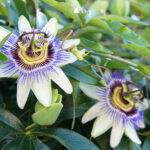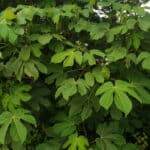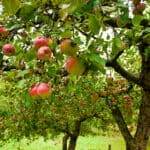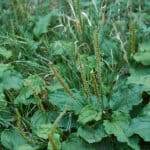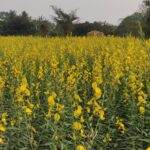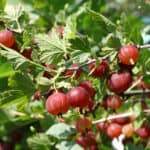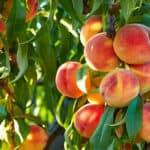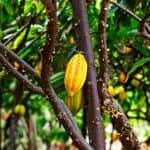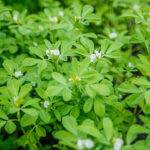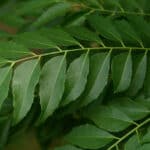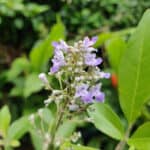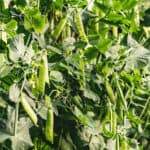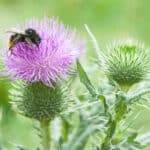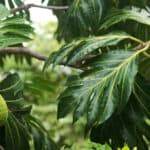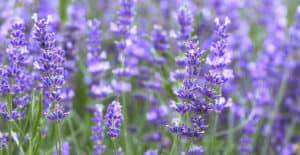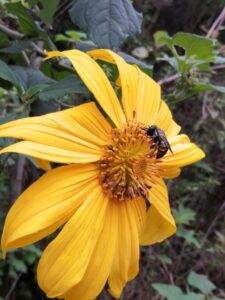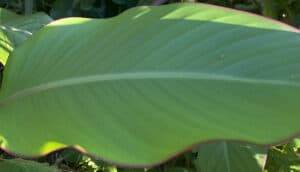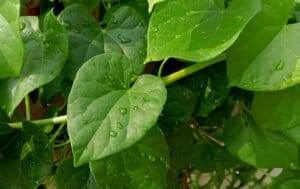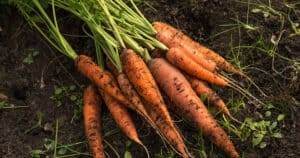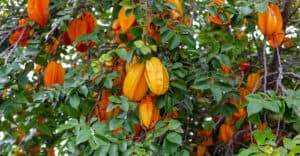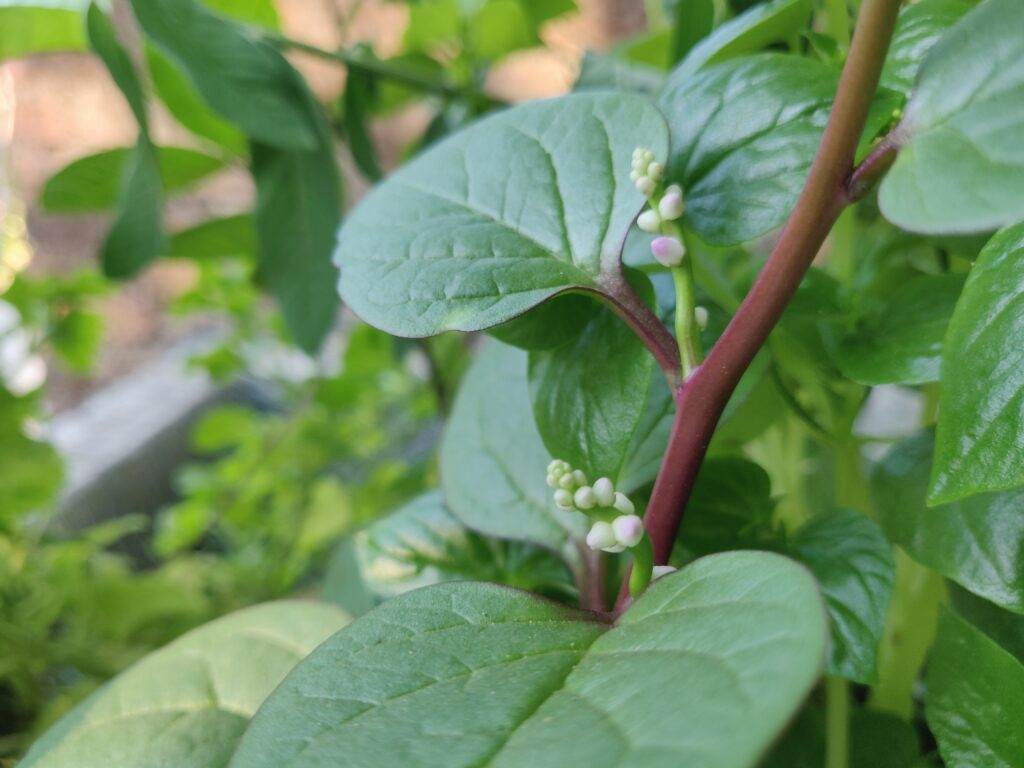
If you are a spinach lover and looking forward to growing it throughout the year, this one’s for you!
This is Malabar Spinach, a fast-growing, twining perennial herb from Asia. It is a great companion that has the potential to benefit humans and their spaces.
In Asia, especially India, it is grown and known for consumption, primarily leaves followed by steam and tender flowers. It is used in folk medicine and is included in local diets for its higher nutritional value like presence of vitamins A and C, iron and calcium, fibre and proteins.
Even though the plant does not represent the true nature of spinach botanically, the leaves and tender stem have a flavor and texture similar to spinach and can be cooked in a similar style. It has a very mild peppery flavor when eaten raw.
The name Malabar Spinach comes from the Malabar region of India, the western coast of present-day peninsular India which is considered as the origin of the species. It is now naturalized in parts of Africa, South America and Australia.
It is called Muer Cai in China, Paag Prang in Thailand, Alugbati in the Philippines and other common names like Indian Spinach, Malabar Nightshade, Gui, Acelga, Bratana, Libato, Climbing Spinach and Vine Spinach.
Some native Indian names include Basale Soppu in Kannada, Bhajyacha Vel and Mayalu in Marathi, Pui Shak in Bengali, Vali Bhaaji in Konkani, and Bachhali in Telugu.
Plant Description
The common name Malabar spinach is used for two major Basella varieties, Basella alba L. (green) and Basella rubra L. (red) the major difference being the color of the stem,flowers and leaves.


It is a climber that either takes support from available structures like other plants, walls and trellis or crawls over the ground trying to send out vertical stems in a mound-like shape, up to a meter high.
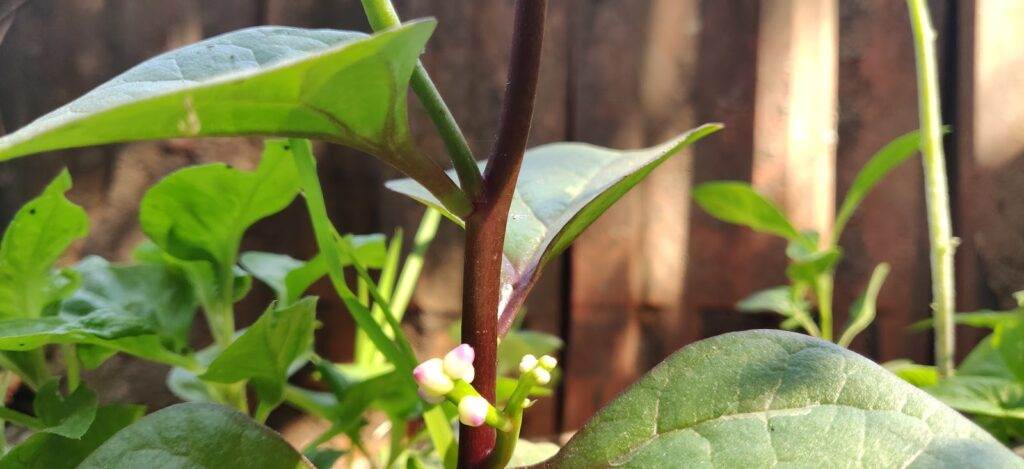
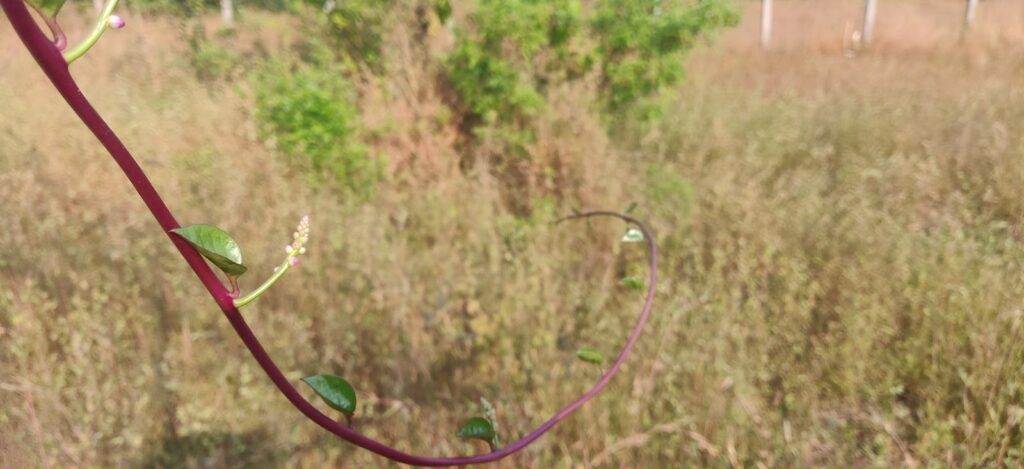
The stem is fleshy, glossy and glabrous, succulent, and much branched. They are thicker at the base and slender at the ends.
The length can vary between 1 to 10 metres long depending on the availability of support. The tender stems are harvested and cooked, they add a nice crunchy texture to dishes, especially salads.
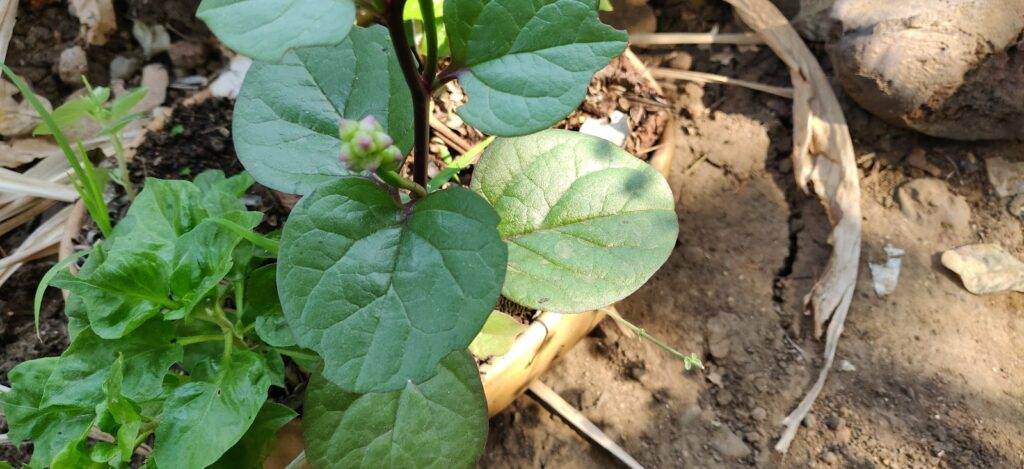
The leaves are axillary, dark green, glossy, succulent and broadly oval or heart-like in shape. They grow larger in shade and with an abundance of water and comparatively smaller in size when the plant is under stress.
They are heat tolerant as long as the ground below is moist and thus can be grown and harvested throughout the year.

Malabar Spinach flowers begin as white or light green with hints of pink, magenta or red at the top. They grow in bunches measuring less than half a centimeter along the nodes and at the tips of the vines. They do not grow large petals and are always slightly white and pod-like.
It flowers throughout the year however is at its peak during summers or when there is reduced availability of water. The flowers are used in cooking and are also made into pickles.
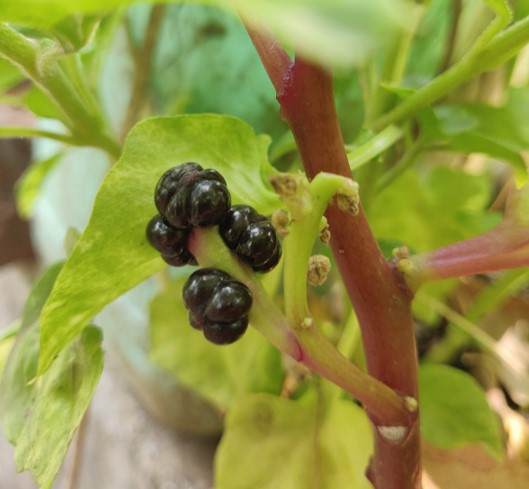
The fruits are pulpy and dark purple in color, they turn slightly dark as they start to dry up. The seeds are enclosed inside the persistent fleshy calyx.
The mature fruit has lots of betalain pigments (gomphrenin-I as major red pigment) which gives the dye a signature red color, along with betanidin dihexose, and isobetanidin dihexose.
The seeds are indehiscent and globular, they turn dark brown to black as they dry up.
Both the flowers and fruits have a mild yet mostly neutral flavor with some peppery and citrus undertones.
Quick Fact: Despite both being edible, Basella alba (green) is preferred to be grown as a vegetable and Basella rubra (red) as an ornamental due to the beautiful hues of red and magenta.
Plant Properties and Regenerative Benefits
Establishes Quickly
The vine is known for establishing quickly under suitable conditions, it grows vigorously, especially when they have the area to spread out. Thus it can be used for quick foliage creation as well. It can start producing yield after 2 to 3 months post plantation from seeds and the leaves and tender shoots can be harvested every 5 to 8 days.
Great for Living Fencing and Privacy Hedges
Traditionally, Malabar spinach was allowed to crawl up on existing living fences or privacy hedges helping make them denser. They can be used for both, adding density and diversity to existing fences as well as being planted with support for new fences, especially privacy hedges.
Stacking Functions
It adds more utility to existing places and structures as it increases the yield by stacking functions and simultaneously looks great aesthetically as well due to the glossy appearance. The red variety (Basella rubra) adds pretty red shades and is a great option to replace non-edible ornamentals as well!
Low Maintenance
The plant is known for adapting to a diverse range of soils pH, nutrient-poor soils, and eroded soils. It can grow in diverse tropical and subtropical climate zones making it a low-maintenance species.
Shade Tolerant
It can tolerate shade and the leaves grow larger and more succulent when grown in dappled shade. It is a great plant to have at the understory level in the food forest.
Micro Climate Zones creation
Malabar Spinach, when grown without human intervention, crawls on the ground and whatever vertical structures are available with dense layers on branches. This helps create a shaded zone that retains moisture and helps host life beneath.
They are great to grow around water bodies to retain moisture around the edges, provide protected and shaded spaces for tiny creatures and keep the area cool.
Nutritional Values
The leaves are a good source of vitamins A and C, iron and calcium, fiber and proteins. And thus it is a great perennial solution for spinach as it can help supply similar medicinal and nutritional benefits.
Medicinal Properties
Malabar Spinach is called Upodika in Ayurveda. It is used in folk medicine for its antibacterial activity, anti-inflammatory and antiviral properties that help treat wounds and issues related to the urinary tract, blood pressure, digestion, liver and kidney stones.
It is rich in a flavonoid called Kaempferol which is protective against cancer and cardiovascular issues.
Leaf paste is used for healing boils and soreness of the skin.
The roots have strong astringent properties, it is used as a rubefacient to help increase blood circulation. They are also used in home remedies to treat diarrhoea.
The flowers are believed to be an antidote for snake poison.
Growing and Caring
In India, Malabar Spinach is planted across the low-lying zones where the soils are moist. It is pretty easy to grow and care for if you are growing it in tropical or subtropical zones and it can be propagated easily through seeds and cuttings.
Selecting and Creating the Right Micro-environment
Temperatures and Climate Zones
It thrives in tropical zones, hot and humid climates and temperatures ranging in between 25 to 35 °c and can tolerate a range of 10 to 40 °c. It can be found growing in elevations up to 1500 meters.
It is sensitive to colder temperatures, and can tolerate up to 10 °c, however, ceases to grow when temperatures drop further. If you don’t have freezing temperatures, the plant can make it through colder seasons as long as there’s no frost. It can be grown as an annual in temperate zones with lower humidity and frost.
Soil
It thrives in moist, well-drained, nutrient-rich soils however can tolerate poor soil conditions and a diverse pH ranging from 4 to 7.5 and thrives in the range of 5 to 6.
Sun
It grows well in both full sun and shaded regions.
Water
It needs moist soils however cannot stand waterlogging. It grows well in heavy rainfall regions and can tolerate a scale of 500 to 3000 mm of mean annual rainfall.

Nutrition
It loves organic matter-rich soils and thus adding compost every now and then helps. Once established, it can self-sustain as long as there’s enough water available.
Pest & Diseases
It is known for being resistant to pests and diseases in tropical zones.
Interesting Fact: Traditionally, Malabar Spinach was planted near compost pits or grey water zones as there was a good amount of food residues being deposited and the cleaning agent back then were local biodegradable ones like soapnuts, ash, flour and more.
Propagating Malabar Spinach
Once being sure about having or creating above mentioned growing conditions for the plant, you can start looking for seeds from local growers or online. It can be propagated successfully from cuttings as well.
Growing from Seeds
Germinating from seeds is pretty easy, just requires warm temperatures and adequate moisture with well-draining soils.
You can sow one to two seeds per pot and aim for keeping the soil moist throughout the period. It takes around a week or two (longer at times) for germination and can be transferred to a permanent spot in the farm or a bigger pot once it grows a foot high with 6 to 8 sets of leaves.
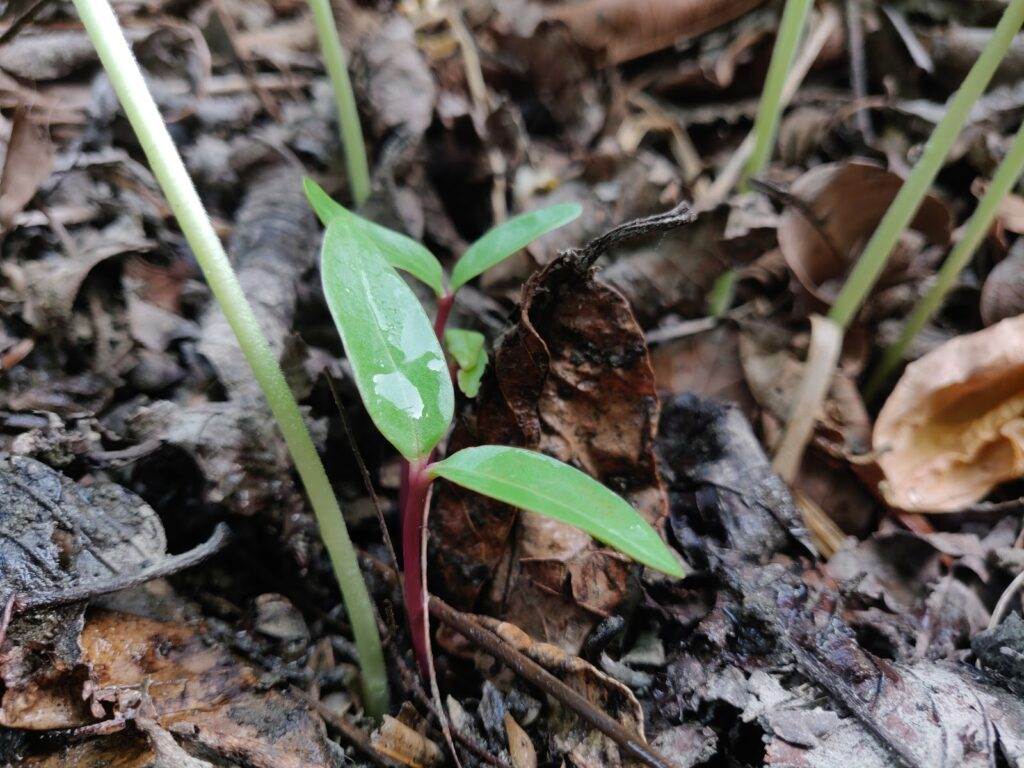
The seeds can be sown directly into well-draining moist soils in the field. They can be sown any time of the year however they germinate well during monsoons when the humidity is high. The plant self-seeds and germinates around existing plants often.
Germination Tips:
When growing as annuals in frost zones, I recommend starting 5 to 6 weeks, indoors, before the last frost.
For faster germination, some mechanical scarification can be done to reduce the seed coat by rubbing them against sandpaper or you can simply soak the seeds in lukewarm water overnight or up to 24 hours before sowing.
Growing from Stem Cuttings
Stem cuttings can be obtained from existing plants, they grow roots within a week of plantation.
The cuttings need to be 20 to 25 cm long and sourced from mature branches and not tender shoots.
Ensure that there are 3 to 4 nodes on the selected cutting for a better success rate.
The cuttings can be transferred directly to well-draining and nutrient-rich soils, 2 to 3 inches into the soils. They can be grown directly in the garden or field or grown in pots with potting mix and later transferred to desired locations.
They root readily throughout the year when they touch moist soils and thus can be propagated anytime. Just remember to plant them on the same day or add a ball of soil at their base

Propagation Tip:
The plant grows well when the soils are warm and moist, both from seeds and cuttings, thus making the most of your warm soils!
Growing Tip:
When growing as perennials, ensure at least 5 to 10 feet of distance in between 2 consecutive plants. When planting as annuals, you can plant them closer in a range of 3 to 7 feet.
Caring for Malabar Spinach
As much as Malabar spinach grows really well without human intervention once established, a little interference goes a long way toward ensuring an abundant yield.
Pruning
Regular pruning, especially harvesting new and tender shoots for consumption helps the plant grow more branches and thus achieve a better spread.
Adding Organic Matter
Adding a little organic matter every now and then works great for the plant. You can even throw in discarded liquids from your kitchen which are rich in nutrients like discarded water from cooked rice, pasta, millet, meat, dairy products and more.
Support
The plant does great when provided support like a trellis or being planted beside other thorny shrubs. It promotes branching. The plant wraps itself around support and doesn’t grow smaller side tendrils like gourds thus it needs a sturdy support.
Water & Warmth
It thrives in moist soils with higher humidity and warm temperatures thus figuring out warm spots and planting it there along with regular irrigation to keep the soils moist.
The leaves turn bitter and the plant goes into the flowering stage when the soils dry up, thus moist soils are a must when you wish to consume the plant.
Invasive Concerns
Unlike any new plant being introduced to non-native zones, it is recommended to experiment in a controlled environment before introducing the plant to larger or wild zones of the farm as it can go invasive due to it’s self seeding and quick rooting behaviour.
Saving Malabar Spinach Seeds
Seeds can be saved by simply letting them ripe on the plant and pulling them gently when they look ripe.
Sundry the seeds and they can be then stored in ziplock bags or airtight jars at room temperature for sowing, they stay viable for a year or more.
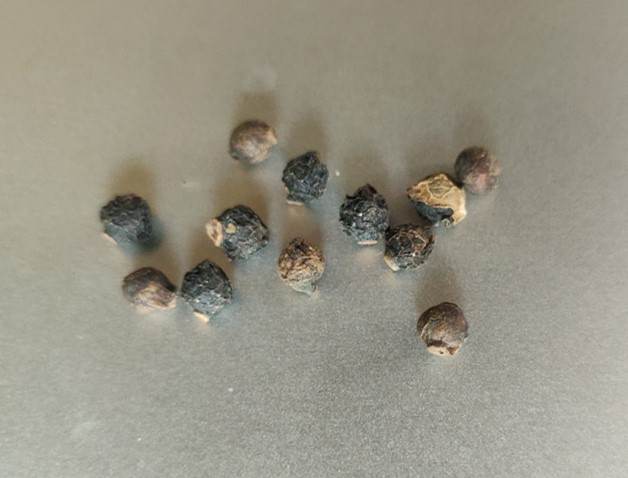
Harvest and Cooking
You can harvest the leaves as soon as the plant establishes and reaches a height of one to two meters. You can use a pair of scissors to harvest leaves and tender shoots and do it by using your thumb and forefinger to pinch each leaf off as well.
Throughout India, the leaves and tender stem are used in traditional recipes in diverse forms. In Andhra Pradesh, they are cooked into a curry with yams, in Kerala they are used to make sauteed greens and curries, in northern India they are made into pakoras by frying in batter.
Some Quick Malabar Spinach Recipes
Stir fry
Stir-frying brings out the earthy and slightly peppery flavors of Malabar Spinach. All you need is 5 ingredients, Malabar spinach shoots, ginger, oil, salt and some pepper.
Wash and broadly chop the shoots. Heat a tablespoon of oil in a pan, add an inch long grated ginger, add the spinach, and stir fry until the spinach becomes soft, however, do not overcook it. Top it with salt and pepper as per preference.
You can add herbs and spices as per choice, I personally love to add minced garlic, chilies and mustard oil.
Fried Malabar Spinach Fritters/ Pakoras
This is a quick deep-fried dish, made especially during monsoon as hot pakoras are preferred during rains. All you need to do is harvest some leaves, wash and dry them, create a batter of chickpea flour, water and salt, batter the leaves and deep fry them. You can even crispy bake or air fry them if you wish to avoid oil.
The batter can be made crispier by adding in some rice flour to the chickpea batter. You can dip it in sauce or eat it with a chutney.
Malabar Spinach Curry
The curry recipe is slightly extensive however it’s flavorful and tastes amazing, here’s a link to recipe
Serving Quantity Idea: 5 to 8 shoots with leaves can cook one serving worth of sauteed veggies.
Using Malabar Spinach Dye

Last, but not least, the fruit pulp juice extracts a beautiful reddish-purple dye, which has been used as an ink for colouring foods.
It is locally preferred as a dye for official seals.
As kids, I remember us collecting ripe fruits and scribbling them on paper or cloth to draw or paint with the dye. We also used to apply the dye to our lips and cheeks as a tint for fun.
Painting with Malabar Spinach Fruit Dye is a great activity to include for children to help them interact with nature. It is pretty simple as one has to just pluck a handful of ripe fruits, squeeze them a bit to extract the dye, dip the brush and use it as watercolor to paint.
The color changes over a period however can be retained by adding a tiny amount of baking soda or other mediums.
Conclusion
Despite the traditional usage and cultivation practices, Malabar Spinach is slowly being forgotten due to the growing production and availability of mainstream monoculture produce. It is currently an underutilized plant with great potential and thus needs to be incorporated consciously in designs and both small and large growing spaces.
References
Deshmukh SA and Gaikwad DK (2014). A review of the taxonomy, ethnobotany, phytochemistry and pharmacology of Basella alba (Basellaceae). Retrieved from https://japsonline.com/admin/php/uploads/1174_pdf.pdf
Kumar SS, Manoj P, Shetty NP, Prakash M, and Giridhar P (2014). Characterization of major betalain pigments -gomphrenin, betanin and isobetanin from Basella rubra L. fruit and evaluation of efficacy as a natural colourant in product (ice cream) development. Retrieved from https://pubmed.ncbi.nlm.nih.gov/26243919/




